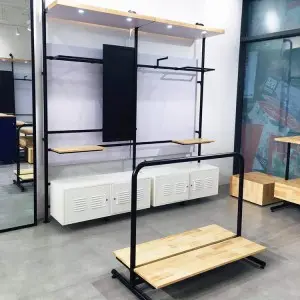Aug . 06, 2024 10:00 Back to list
Creative Store Merchandising Ideas for Enhancing Fixtures and Eye-Catching Displays
Store Fixtures and Displays The Art of Creating a Compelling Retail Environment
In the competitive world of retail, the ambiance and layout of a store can make a significant difference in attracting customers and encouraging purchases. Store fixtures and displays play a crucial role in this process, serving as both a functional and aesthetic component of the shopping experience. This article will explore the importance of store fixtures and displays, various types available, and best practices for creating an engaging retail environment.
The Importance of Store Fixtures and Displays
Store fixtures are essential for organizing and showcasing products effectively. They include shelving, racks, mannequins, counters, and other elements that support product visibility and accessibility. Well-designed fixtures not only help in maximizing space but also influence the way customers perceive a brand. In a saturated market where consumers are often overwhelmed by choices, a thoughtfully arranged store can create a unique shopping experience that draws people in.
Displays, on the other hand, are more focused on the presentation of specific products or promotional items. They can create a visual focal point that attracts attention and encourages impulse buying. Seasonal displays, themed setups, and educational signage can all enhance the shopping experience, guiding customers towards selected items and informing them about special offers.
Types of Store Fixtures and Displays
1. Shelving Units These are the backbone of any retail space, providing a sturdy and organized way to present products. They come in various sizes and styles, allowing for flexibility in layout and product placement.
2. Mannequins Frequently used in clothing and accessory stores, mannequins create a visual representation of the products being sold. They help customers visualize how items may look when worn, thereby enhancing the likelihood of purchase.
3. End Caps Positioned at the end of aisles, end caps are prime real estate for displaying promotional items or seasonal products. They catch the eye of shoppers and serve as an opportunity to highlight special deals.
4. Freestanding Displays These are versatile fixtures that can be placed anywhere in the store. They often feature promotional items and are effective in drawing attention to new or trending products.
store fixtures and displays

5. Point of Sale (POS) Displays Located near the checkout area, POS displays can effectively stimulate last-minute purchases. Items such as snacks, magazines, and small gadgets are commonly found here, targeting impulse buyers.
Best Practices for Creating Effective Store Fixtures and Displays
1. Know Your Audience Understanding your target demographic is fundamental when designing fixtures and displays. Tailor your layout and presentation to resonate with your specific customer base, considering factors such as age, interests, and shopping habits.
2. Focus on Visual Appeal Use color, lighting, and texture to create an inviting atmosphere. Bright colors can attract attention, while softer tones can create a calming environment. Proper lighting can highlight products and enhance their appeal.
3. Utilize Space Wisely An organized layout is key to a successful retail environment. Avoid clutter and ensure that fixtures allow for easy navigation. This not only makes the shopping experience more pleasant but also encourages customers to spend more time in-store.
4. Change It Up Regularly update your displays to reflect new arrivals, seasonal trends, or special promotions. Frequent changes keep the shopping environment fresh and encourage repeat visits.
5. Incorporate Technology With the rise of digital retail experiences, incorporating technology into store fixtures can set a business apart. Interactive displays and digital signage can enhance customer engagement and provide valuable information.
Conclusion
In conclusion, store fixtures and displays are vital elements in crafting a successful retail environment. By focusing on aesthetics, functionality, and customer engagement, retailers can create spaces that not only attract customers but also drive sales. As the retail landscape continues to evolve, staying current with trends in store design will be essential for remaining competitive and successful.
-
The Benefits of Electronic Shelf Labels for Modern Stores
NewsJul.01,2025
-
Space-Saving Retail Store Furniture Designs for Small Shops
NewsJul.01,2025
-
Slatwall vs. Gridwall: Which Store Fixture is Right for Your Business?
NewsJul.01,2025
-
Shop Fittings: Essential Elements for a Functional Retail Space
NewsJul.01,2025
-
How to Design a Minimalist Cosmetic Shop Display
NewsJul.01,2025
-
Creative Clothes Shop Display Ideas to Attract More Customers
NewsJul.01,2025


















































































































